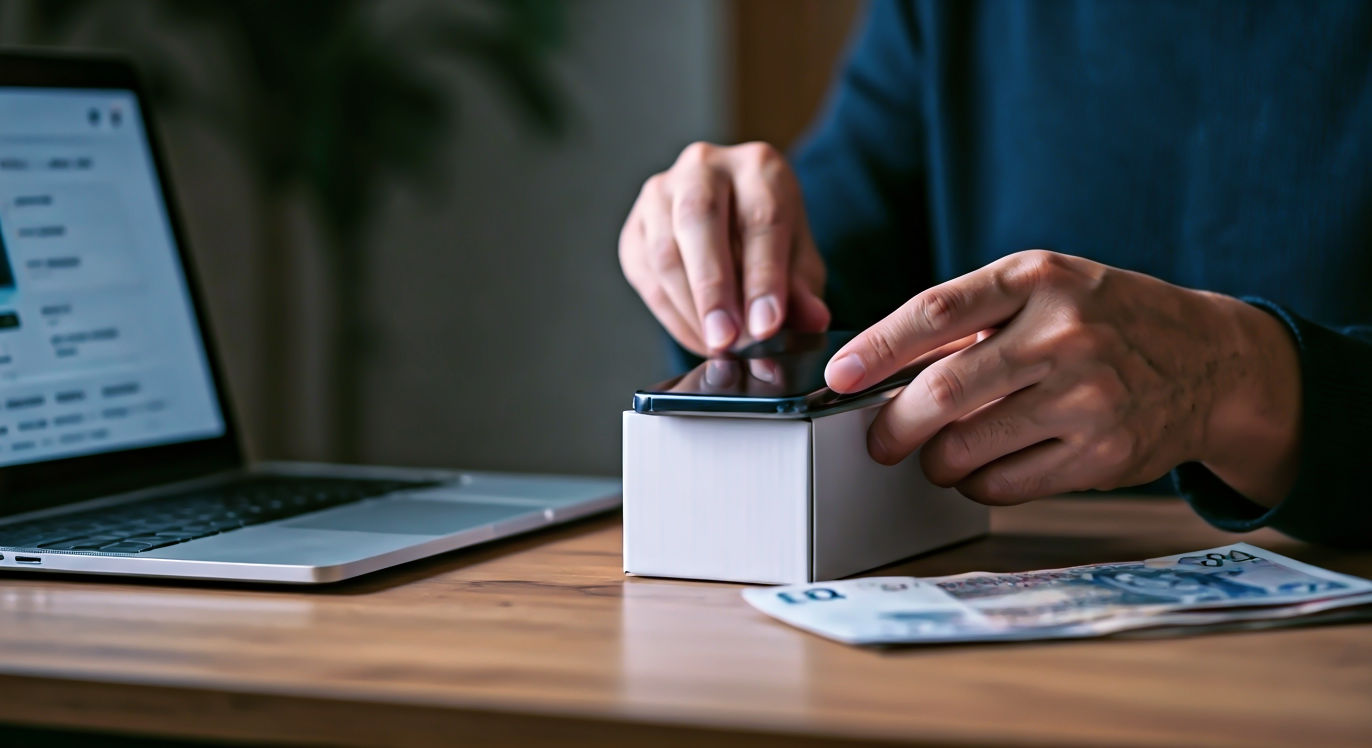Sell Your iPhone: The Guide to Getting the Most Cash in the UK
Your definitive guide to selling an iPhone in the UK. Follow our 12 expert tips to get more cash, from preparing your device to finding the best buyer.

This post may contain affiliate links. If you make a purchase through these links, we may earn a commission at no additional cost to you.
Got an old iPhone gathering dust in a drawer? You’re not alone. Millions of us have perfectly good phones that we’ve replaced with the latest shiny model. But that old device isn’t just clutter; it’s a little bundle of cash waiting to be released. In a time when every quid counts, selling your old tech is one of the smartest and simplest ways to give your bank balance a boost.
Whether you’re saving up for a new gadget, putting money towards a holiday, or just fancy a bit of extra spending money, that old iPhone is your ticket. But selling it can feel like a faff. Where do you go? How do you get the best price? And how do you make sure your personal data stays, well, personal?
Fear not. This is your ultimate guide. We’re going to walk you through everything, step-by-step. Forget the jargon and confusion. Think of this as a chat with a tech-savvy mate who knows all the tricks. We’ll cover 12 essential tips that will take you from a dusty iPhone to a happy payday, quickly and profitably.
Why Bother Selling Your Old iPhone?
Beyond the obvious—getting cash for something you don’t use—there are a couple of other great reasons. Firstly, it’s brilliant for the planet. Phones are packed with precious materials, and recycling them or giving them a new life with someone else is far better than letting them end up in a landfill.
Secondly, the money you make can seriously cut the cost of your next upgrade. That new iPhone doesn’t seem quite so pricey when you’ve got £200 or more from your old one to put towards it.
So, let’s get down to business. Here are the 12 tips you absolutely need to know.
Tip 1: Timing is Everything—Sell Before the Hype
If you want the top price for your iPhone, when you sell is just as important as where you sell. Apple typically launches its new iPhones every September. In the weeks leading up to the announcement, excitement builds, and people start thinking about upgrading.
This is your golden window.
The moment a new iPhone is announced, the value of all the older models takes a nosedive. Think about it: why would someone pay top dollar for an iPhone 15 when the brand new iPhone 16 is out? Recycling sites and private buyers get flooded with older phones, so the prices they offer drop, sometimes by as much as 20-30% overnight.
Action Plan:
- Sell in August or early September. This is the sweet spot. You’ll catch buyers who are looking to upgrade and are willing to pay a good price before the market is saturated.
- Lock in a price. Many UK recycling websites, like MusicMagpie or Mazuma, let you lock in your quote for 14 or even 28 days. You can get a quote in August, keep using your phone, and then send it off after you’ve got your new one in late September. You get the high price without being left phoneless.
Tip 2: Know Your Model, Know Its Worth
Before you can get an accurate quote, you need to know exactly what you’re selling. “An old iPhone” isn’t enough. Buyers need three key bits of information:
- The Exact Model: Is it an iPhone 14 Pro, an iPhone 13, or an iPhone SE?
- The Storage Capacity: This is measured in gigabytes (GB)—usually 64GB, 128GB, 256GB, or more. More storage means more money.
- Its General Condition: We’ll cover this in detail in Tip 7.
How to find your iPhone’s model and storage:
- Grab your iPhone.
- Go to Settings > General > About.
- You’ll see the Model Name (e.g., iPhone 14) and the Capacity right there. The capacity number is the total storage, not what you have left.
Once you have this info, you can start getting a rough idea of its value. Pop the details into a comparison site (more on that in Tip 10) to see what it’s currently fetching.
Tip 3: The Big Clean-Up (Your Digital Life)
This is probably the most important step of all. Your iPhone holds your life: photos, messages, contacts, banking apps, emails. You absolutely do not want to hand that over to a stranger. Before you do anything else, you need to back up your data.
This saves all your precious information, so you can transfer it seamlessly to your new phone. You have two main options for this: iCloud or your computer.
How to Back Up to iCloud
This is the easiest method. It backs up your data wirelessly to Apple’s online storage.
- Make sure your iPhone is connected to a Wi-Fi network.
- Go to Settings > [Your Name] > iCloud.
- Tap on iCloud Backup.
- Make sure iCloud Backup is turned on.
- Tap Back Up Now.
Stay connected to Wi-Fi until the backup is complete. It might take a while if you’ve never done it before.
How to Back Up to a Computer
If you don’t have enough iCloud storage, or just prefer having a local copy, you can use a Mac or a Windows PC.
- On a Mac: Connect your iPhone to your Mac with a USB cable. Open Finder and select your iPhone in the sidebar. Click General, then choose “Back up all of the data on your iPhone to this Mac.” Click Back Up Now.
- On a Windows PC: You’ll need to have iTunes installed. Connect your iPhone to your PC, open iTunes, click the little iPhone icon near the top left, go to Summary, and then click Back Up Now.
Once the backup is finished, you’re ready for the next crucial privacy step.
Tip 4: Sign Out and Secure Your Privacy
Imagine selling a house but leaving the front door key in the lock. That’s what selling an iPhone without signing out of your Apple ID is like. It’s a security risk, and more importantly, it makes the phone useless to the next person.
A feature called Activation Lock (linked to Find My) is automatically enabled when you set up your iPhone. It’s designed to stop thieves from being able to wipe and use your phone if it’s stolen. If you don’t turn this off, a recycler won’t pay you, and a private buyer will have a very expensive paperweight.
This is a non-negotiable step.
How to Sign Out of iCloud and Turn Off Find My
- Open Settings.
- Tap on [Your Name] at the very top.
- Scroll all the way down and tap Sign Out.
- You’ll be asked for your Apple ID password to turn off Find My. Enter it.
- You’ll then be asked if you want to keep a copy of your data (like contacts and calendars) on the device. Since you’re about to wipe the phone completely, it doesn’t matter what you choose, but it’s tidier to untick everything.
- Tap Sign Out again to confirm.
Once you’re signed out, your personal account is untied from the device. Now, it’s time to erase everything.
Tip 5: The Full Wipe—Perform a Factory Reset
With your data backed up and your account disconnected, it’s time to wipe the phone clean, returning it to the state it was in when you first took it out of the box. This is called a factory reset.
It will erase absolutely everything: your apps, photos, messages, settings, everything. Make 100% sure you’ve completed Tip 3 and Tip 4 before you do this.
How to Factory Reset Your iPhone
- Go to Settings > General.
- Scroll to the bottom and tap Transfer or Reset iPhone.
- Tap Erase All Content and Settings.
- A screen will pop up summarising what will be erased. Tap Continue.
- You may be asked for your passcode. Enter it.
- The phone will then start the erasing process. It will show the Apple logo and a progress bar. This takes a few minutes.
When it’s finished, the phone will restart and show the “Hello” screen in different languages. That’s it! It’s now a clean slate, safe to sell. Do not set it up again. Just switch it off.
Tip 6: Is It Unlocked? Check Your Network Status
An iPhone can either be “locked” to a specific mobile network (like EE, O2, or Vodafone) or “unlocked,” meaning it can be used with a SIM card from any network.
Unlocked phones are worth more money.
Why? Because the buyer has the freedom to use any network they choose. It makes your phone much more attractive, especially to private buyers and even to recycling companies, who often pay a premium for them.
Most iPhones sold in the UK in the last few years are sold unlocked, but if you bought yours as part of a contract a while ago, it might be locked.
How to Check if Your iPhone is Unlocked
The easiest way is to try a SIM card from a different network.
- Borrow a SIM from a friend or family member who is on a different network to you. (For example, if you’re on O2, borrow a Vodafone or EE SIM).
- Turn off your iPhone.
- Use a SIM-eject tool (or a bent paperclip) to pop out your SIM tray.
- Swap your SIM for the other one and push the tray back in.
- Turn the phone on.
- Try to make a phone call. If it connects, your phone is unlocked! If you see a message like “SIM Not Supported” or “SIM Not Valid,” your phone is locked.
How to Unlock Your iPhone
If it’s locked, don’t panic. It’s usually free and easy to get it unlocked. You just need to contact the network it’s locked to. You’ll usually need your account details and the phone’s IMEI number (you can get this by dialling *#06# on the phone’s keypad).
Most networks have an online form you can fill out. It can take a few days, so do this well in advance of selling.
Tip 7: Judge the Condition Honestly
This is where you need to be a bit of a tough critic. The amount you’re offered is directly tied to your phone’s physical condition. Recycling companies have strict grading categories, and if you claim your phone is in better nick than it is, they’ll just lower their offer when they receive it. It saves everyone time if you’re honest from the start.
Grab your phone and inspect it under a bright light. Here are the typical grades:
- Excellent / Good / Pristine: This is a phone that looks almost new. It might have a few very faint, tiny scratches on the screen or body that you can only see if you really look for them. No dents, no cracks, no deep scratches. Everything works perfectly.
- Fair / Average: This is a phone that’s been used. It will have noticeable signs of wear and tear, like light scratches on the screen and scuffs or small dents on the corners and edges. But there are no cracks in the glass (front or back) and everything still works.
- Poor / Faulty: This phone has serious problems. This could be a cracked screen, a broken camera, faulty buttons, deep dents, or it might not turn on at all.
Be brutally honest with yourself. A tiny scratch to you might be a ‘Fair’ grade to a buyer. A better grade means more money, but an inaccurate one just leads to disappointment later.
Tip 8: Gather the Goods—Box and Accessories
If you’re planning to sell privately on a site like eBay or Facebook Marketplace, this tip can make a real difference. People love getting the “as new” experience.
Dig around in your cupboards and find the original box your iPhone came in. If you still have the original, unused charger cable and plug, even better. While it won’t drastically increase the price, a boxed iPhone with its accessories often sells faster and for a slightly higher price than a loose handset.
It makes your listing look more professional and trustworthy. It shows you’re a careful owner.
For recycling companies, it usually doesn’t matter. They just want the handset. But for a private sale, it’s a simple trick to make your phone stand out from the crowd.
Tip 9: Choose Your Battlefield—Where to Sell
You’ve prepared your iPhone, and now you’re ready to sell. You have five main options in the UK, each with its own pros and cons.
1. Online Recycling Companies
- Examples: MusicMagpie, Mazuma, Envirofone.
- How it works: You enter your phone’s details on their website and get an instant quote. If you accept, they send you a free postage pack. You pop your phone in the post, and once they check it, they pay you via bank transfer.
- Pros: Incredibly easy, fast, and convenient. No dealing with fussy buyers or silly questions.
- Cons: You will almost always get less money than selling it yourself.
2. Online Marketplaces
- Examples: eBay, Gumtree, Facebook Marketplace.
- How it works: You create a listing, take photos, write a description, and set your price. You then deal with potential buyers, arrange payment, and post the phone.
- Pros: This is where you’ll get the highest possible price.
- Cons: It’s the most effort. You have to deal with buyers (who can be unreliable), package the item yourself, and be wary of potential scams. eBay also takes a cut of your final sale price.
3. High Street Retailers
- Example: CEX.
- How it works: You take your phone into one of their shops. They’ll test it there and then and offer you a price. You can choose cash or a higher-value store credit voucher.
- Pros: Instant payment. You can walk out with cash in your hand in under an hour.
- Cons: The cash price they offer is often lower than online recyclers.
4. Your Mobile Network Provider
- Examples: EE, O2, Vodafone, Three.
- How it works: Most networks offer a trade-in scheme when you take out a new contract or upgrade. They’ll take your old phone and give you a discount on your new plan.
- Pros: Very convenient if you’re upgrading with the same network anyway.
- Cons: You don’t get cash. The value is often only given as credit against a new, expensive contract.
5. Apple Trade In
- How it works: You can trade in your old iPhone directly with Apple, either online or in-store.
- Pros: Simple and trustworthy process, fully integrated if you’re buying a new product from Apple.
- Cons: You only get an Apple Store gift card, not cash. Their trade-in values are also often significantly lower than what you could get elsewhere.
Which is best?
- For maximum cash: Sell it yourself on eBay.
- For maximum convenience: Use an online recycler like MusicMagpie.
- For a quick and easy balance: Compare recyclers (see Tip 10).
Tip 10: Compare, Compare, Compare
If you decide to go with an online recycler, do not just go to the first website you think of. Prices can vary wildly between companies for the exact same phone. One site might be offering £250 while another is offering £300.
This is where comparison websites are your best friend.
- Examples: CompareMyMobile, SellMyMobile.
These sites are like the GoCompare or MoneySuperMarket for phone recycling. You enter your iPhone’s details once, and they show you a live list of the prices being offered by dozens of different UK recycling companies.
You can see at a glance who is offering the most money. They also feature user reviews, so you can see if a company is reliable and pays out quickly. Using one of these sites takes two minutes and can easily earn you an extra £20-£50. It’s a no-brainer.
Tip 11: Get Snap Happy—Taking Great Photos
This tip is purely for those selling privately on eBay, Gumtree, or Facebook. Your photos are your sales pitch. People buy with their eyes, and a blurry, dark photo makes your phone look dodgy.
You don’t need a fancy camera; your new phone will do just fine.
- Clean the phone first! Wipe off all the fingerprints and dust with a soft cloth.
- Use a neutral background. A plain white wall, a clean table, or a sheet of paper works perfectly. Avoid cluttered backgrounds.
- Use natural light. Take your photos near a window during the day. Avoid using your flash, as it creates harsh glare.
- Take lots of pictures. Show the phone from every angle: front, back, all four sides.
- Show the screen turned on. Take a picture of the “Hello” screen to prove that it works.
- Be honest about damage. If there’s a scratch or a dent, take a clear, close-up photo of it. Buyers appreciate honesty and it prevents disputes later.
Good photos build trust and make your listing look far more appealing.
Tip 12: Pack It Up and Ship It Out Safely
You’ve found a buyer or accepted a quote. The final step is getting the phone to them safely. Don’t just chuck it in an envelope.
- Wrap it well. Bubble wrap is your best friend. Wrap the phone in a few layers.
- Use a sturdy box. Don’t use a flimsy jiffy bag. A small, strong cardboard box is much safer and will stop the phone from getting bent or crushed in transit.
- Use a tracked and insured service. This is essential. When sending something as valuable as an iPhone, you need protection. Royal Mail Special Delivery is the gold standard in the UK. It’s tracked, insured up to at least £500, and guaranteed to arrive the next day. It costs a bit more, but the peace of mind is priceless. Don’t try to save a few quid by using standard post. If it gets lost, you’ll lose everything.
If you’re sending it to a recycling company, they’ll usually tell you which service to use as part of their free postage pack. Follow their instructions carefully.
Conclusion: From Old Tech to New Money
And there you have it. Selling your iPhone doesn’t have to be a headache. By following these 12 tips, you can navigate the process with confidence. You’ll protect your personal data, avoid common pitfalls, and, most importantly, you’ll get the best possible price for your old device.
To recap the absolute essentials: back up your data, sign out of your accounts, wipe the phone clean, and compare prices before you commit. Whether you choose the easy path of a recycler or the more profitable route of a private sale, you’re now equipped to turn that forgotten gadget into a welcome injection of cash. So go on, dig out that old phone and see what it’s worth. You might be pleasantly surprised.
Further Reading
For checking values and comparing UK recycling companies, these resources are highly recommended:
- CompareMyMobile: https://www.comparemymobile.com/
- SellMyMobile: https://www.sellmymobile.com/
For official Apple guidance on preparing your device:
- Apple Support: https://support.apple.com/en-gb/HT201351






